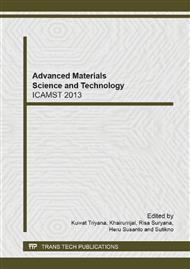p.288
p.292
p.296
p.300
p.305
p.310
p.314
p.318
p.322
Effects of Surface Treatments on Nata de Cassava on the Tensile Strength and Morphology of Bacterial Cellulose Sheet
Abstract:
Cellulose is natural fiber source that available abundant in the world. Besides lignin, hemi cellulose and wax, cellulose is the most component of plant. Cellulose can be produced from secretion of bacteria. Kind of bacteria that can produce cellulose are pseudomonas, Achromobacter, Alkaligene and Acetobacter, but bacteria strain that usually used to produce cellulose called bacterial cellulose is Acetobacter xylinum. Culture medium of Acetobacter xylinum are medium that contain of carbon and nitrogen. One of the medium that contain carbon and nitrogen is tapioka waste water. The gel that produce from tapioka water called nata de cassava. Cellulose fiber that produce from nata de cassava more pure than that from plant. Mechanical properties of single bacterial cellulose fiber as young’s modulus is 114 GPa and tensile strength is 78 GPa. Nata de cassava is produced with 1% sugar consentration and fermentation time is 14 days. pH of tapioka water medium is adjusting by acetic acid glacial. Nata de cassava gel washed for 2 days on running water than soaked in NaOH and NaOCl solution. Than washed on running water than dried on light pressure (0,2 MPa) and oven for an hour on 80°C. this bacterial cellulose film is ready to used as spesiment of tensile test and SEM observation. The aim of this research is to find the effect of surface treatments (Merserizing and Bleaching) on nata de cassava gel on mechanical properties and morfology of bacterial cellulose sheet. From the research find that NaOH treatment give the highest tensile strength of bacterial cellulose sheet compared to NaOCl treatment of nata de cassava.
Info:
Periodical:
Pages:
305-309
Citation:
Online since:
February 2014
Authors:
Keywords:
Price:
Сopyright:
© 2014 Trans Tech Publications Ltd. All Rights Reserved
Share:
Citation:


